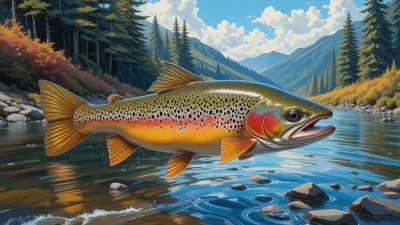Nehalem River Trout Fishing
Nehalem River Trout Fishing – Learn the best trout fishing spots, seasons, techniques, and gear to catch cutthroat and rainbow trout in Oregon’s Nehalem River.

Introduction to Trout Fishing on the Nehalem River
Oregon is renowned for its world-class trout streams, and among them, the Nehalem River stands out as a tranquil yet productive fishery. While more widely known for its salmon and steelhead runs, the Nehalem offers excellent opportunities for trout anglers seeking a quiet, rewarding experience. Whether you're fly fishing for wild coastal cutthroat or tossing spinners for rainbows, Nehalem River Trout Fishing delivers exciting challenges and beautiful scenery.
The river winds through lush forests, rolling hills, and small mountain valleys—creating prime habitat for resident trout and sea-run cutthroat that return in late summer. This guide covers everything you need to know for a successful trout fishing trip on the Nehalem.
Trout Species Found in the Nehalem River
Coastal Cutthroat Trout
The most common trout species in the Nehalem is the coastal cutthroat. These hardy fish are known for their aggressive strikes, beautiful coloration, and occasional migration between freshwater and saltwater.
- Resident Cutthroat: Live year-round in the upper tributaries and main river.
- Sea-run Cutthroat (Bluebacks): Return from the ocean in late summer and early fall.
Rainbow Trout
While not as abundant as cutthroat, rainbow trout are occasionally found in the upper reaches and feeder streams, particularly near cooler headwaters.
Seasonal Distribution
- Spring: Resident trout dominate.
- Late Summer/Fall: Sea-run cutthroat enter the river, especially around tidewater zones.
Best Time of Year to Fish for Trout in the Nehalem
The trout fishing season generally begins in late May and runs through October, depending on regulations and water conditions.
| Season | Trout Activity | Best Tactics |
|---|---|---|
| Late Spring | High activity post-runoff | Dry flies, spinners |
| Summer | Peak season for cutthroat | Fly fishing, light tackle |
| Early Fall | Sea-run cutthroat return | Streamers, soft plastics |
Avoid fishing during high runoff periods in early spring and be cautious of low, warm water in late summer—trout can become stressed during heatwaves.
Top Trout Fishing Locations Along the Nehalem River
Upper Nehalem River
From Vernonia upstream to the Spruce Run area, this stretch offers excellent access to resident trout. It features riffles, pools, and shaded banks ideal for fly casting.
Feeder Creeks and Tributaries
Creeks like Rock Creek, Salmonberry River, and Cook Creek are loaded with wild cutthroat, especially in late summer. These creeks often remain cooler during hot spells.
Hidden Gems
Look for small public access points along Nehalem River Road and forest service roads—many of these lesser-known spots hold untouched trout waters.
Techniques for Catching Trout in the Nehalem
- Fly Fishing: Match the hatch with dry flies during the summer. Nymphs work well in deeper runs.
- Spin Casting: Small spinners (Panther Martins, Rooster Tails) in gold or silver are deadly on cutthroat.
- Bait Fishing: In legal areas, worms or salmon eggs under a float can be productive.
Light gear and stealthy approaches are key in this clear-water fishery.
Gear Recommendations for Nehalem River Trout
Rod and Reel
- Fly Rod: 3–5 weight, 8–9 foot
- Spinning Rod: Light-action, 6–7 foot
Line
- Fly Line: Floating line for dry flies; sink-tip for streamers
- Mono Line: 4–6 lb test for spin casting
Effective Lures & Flies
- Dry Flies: Elk Hair Caddis, Adams, Blue-Winged Olive
- Nymphs: Pheasant Tail, Prince Nymph, Copper John
- Lures: 1/16 oz spinners in bright or natural tones
Fly Fishing for Coastal Cutthroat Trout
These trout are aggressive and willing to chase:
- Dry Fly Strategy: Focus on shaded banks and riffles during morning and evening hatches.
- Streamer Fishing: Cast streamers into deeper pools for sea-run cutthroat later in the year.
-
Best Patterns by Season:
- Summer: Parachute Adams, Stimulators
- Fall: Woolly Buggers, Matukas
Reading the Water for Trout Success
Trout hold in:
- Seams: Where fast and slow water meet
- Under Cutbanks: Especially during sunny days
- Tailouts and Pools: Early morning and late evening
Avoid splashing and wear neutral-colored clothing—trout spook easily in clear water.
Rules, Regulations, and Licensing
Per the Oregon Department of Fish and Wildlife (ODFW):
- Trout Season: Typically late May through October
- License: Oregon angling license required
- Limits: Varies by zone, some areas are catch-and-release only
- Bait Rules: Some sections may be artificial-only